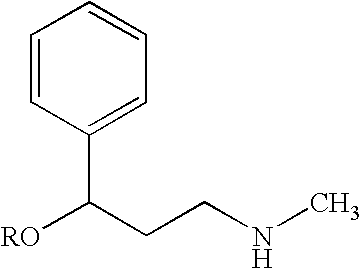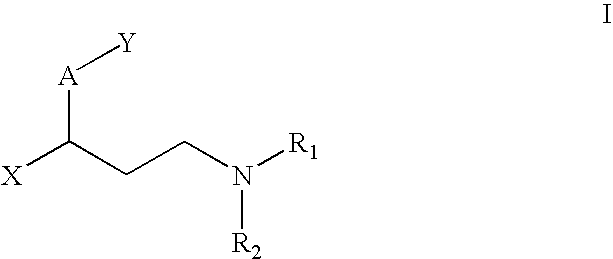Pharmaceutical compounds
- Summary
- Abstract
- Description
- Claims
- Application Information
AI Technical Summary
Benefits of technology
Problems solved by technology
Method used
Image
Examples
preparation 1
(2R,3R)-(3-Propyl-oxiranyl)-methanol
[0100]
[0101] Add trans-2-hexen-1-ol (12 mL, 102 mmol), (−)-diethyl tartrate (2.1 mL, 12.3 mmol), and Ti(OiPr)4 (3.0 mL, 10.2 mmol) to a cooled (−20° C.) solution of activated, dried, crushed 4 Å molecular sieves (50 g) in dichloromethane (700 mL). After 30 minutes, add a dry [JACS, 1987, ]109, 5765] solution of t-BuOOH in dichloromethane (˜5M in dichloromethane, 57 mL, 285 mmol). Stir for 4 hours at −20° C. and filter the solids. Add 700 mL of 15% L-tartartic acid to the filtrate and stir for 20 minutes. Separate the layers, extract the aqueous layer with dichloromethane, and concentrate the combined organic extracts in vacuo. Add 300 mL diethyl ether to residue and cool to 0° C. Add cool (0° C.) 15% NaOH, stir for 15 minutes, separate, and extract aqueous layer with diethyl ether. Wash the organic layer with aqueous saturated sodium chloride, dry over anhydrous MgSO4, filter, and concentrate in vacuo. Purify on silica gel eluting with 0-50% EtOA...
preparation 3
[0103]
[0104] Add sodium bis(2-methoxyethoxy) aluminum hydride (65% wt in toluene, 7.0 mL, 22.4 mmol) to a cooled (0° C.) solution of (R,R)-(3-propyl-oxiranyl)-methanol (0.999 g, 8.60 mmol) in anhydrous THF (48 mL) and stir at 0° C. overnight, and then add 1N HCl at 0° C. Filter the solids, then separate the layers from the filtrate. Extract the aqueous layer with dichloromethane. Boil the solids in EtOAc, decant the solvent, and dry the combined organic extracts over anhydrous MgSO4, filter, and concentrate in vacuo. Purify on silica gel eluting with 100% EtOAc to give (R)-hexane-1,3-diol (550 mg, 54%). 1H NMR (CDCl3) δ 3.93-3.79 (m, 3H), 2.62 (dd, 1H), 2.55 (d, 1H), 1.75-1.58 (m, 2H), 1.54-1.28 (m, 4H), 0.96-0.89 (m, 3H).
preparation 4
(R)-3-Hydroxy-hexanoic acid ethyl ester
[0105]
Catalyst (1):
[0106] Combine dichloro(1,5-cyclooctadiene)ruthenium (117 mg, 0.417 mmol), (R)-BINAP (300 mg, 0.482 mmol), and NEt3 (82.5 μL, 0.59 mmol) in anhydrous toluene (13.5 mL) under N2. Heat the reaction mixture at 140° for 4 hours, and then cool to ambient temperature. Add THF to the resulting red jell, until a solution results. Concentrate the reaction mixture in vacuo, and add THF (30 mL) to the give the catalyst (1) in solution. This solution is used directly for the hydrogenation.
(R)-3-Hydroxy-hexanoic acid ethyl ester
[0107] In a Fisher Porter tube, add the above catalyst (1) solution (10 mL) to a solution of ethyl butyrylacetate (25 g, 0.158 mol) in methanol (100 mL) under N2. Pressurized with H2 (50 psig) and heat at 80° C. for 5 hours. Concentrate the reaction mixture in vacuo. Purify the residue by vacuum distillation (24.45 g, 96%, 97.4% ee). Chiral GC (30 m×0.25 mm×0.25 Am, BETA-Dex 225, 100° C.) second eluting isomer...
PUM
| Property | Measurement | Unit |
|---|---|---|
| Volume | aaaaa | aaaaa |
| Volume | aaaaa | aaaaa |
| Volume | aaaaa | aaaaa |
Abstract
Description
Claims
Application Information
 Login to View More
Login to View More - R&D
- Intellectual Property
- Life Sciences
- Materials
- Tech Scout
- Unparalleled Data Quality
- Higher Quality Content
- 60% Fewer Hallucinations
Browse by: Latest US Patents, China's latest patents, Technical Efficacy Thesaurus, Application Domain, Technology Topic, Popular Technical Reports.
© 2025 PatSnap. All rights reserved.Legal|Privacy policy|Modern Slavery Act Transparency Statement|Sitemap|About US| Contact US: help@patsnap.com



